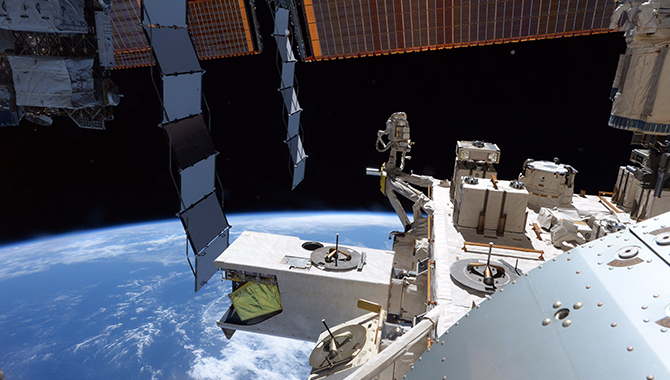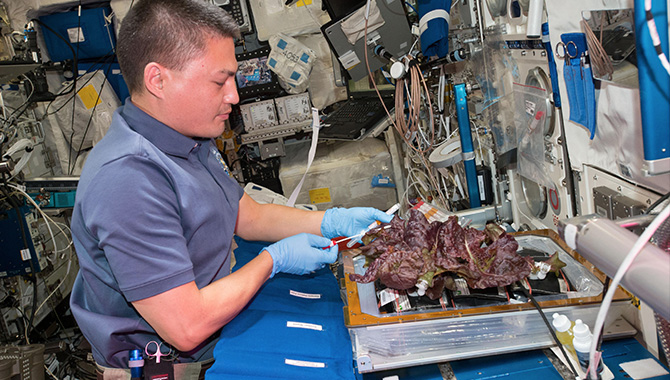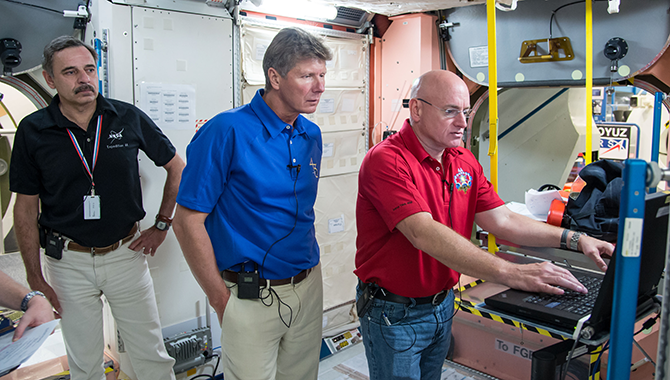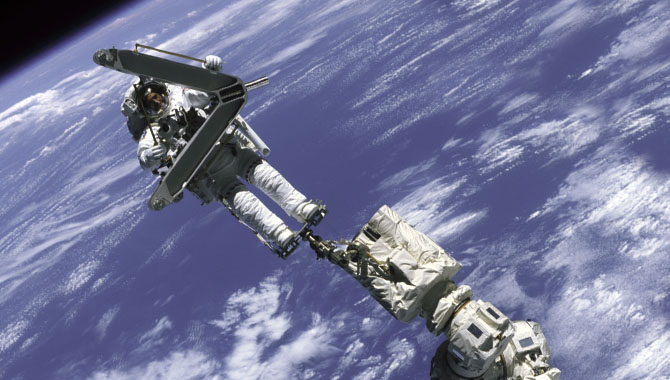
Photo taken from ISS by Expedition 52 crew member NASA astronaut Jack Fischer. The Expedition 52 crew is involved in science investigations on the space station, including research to support future manned missions to deep space.
Photo Credit: NASA
With manned missions to Mars on the horizon, NASA is leveraging the unique capabilities of the International Space Station (ISS) to conduct research into critical exploration technologies.
At the recent International Space Station Research and Development Conference in Washington, DC, Human Exploration and Operations Directorate Associate Administrator William Gerstenmaier led a discussion about how the agency is using the ISS to explore and resolve technological barriers to crewed deep space missions.
“Station is really a one of a kind testbed,” he said. “It’s a catalyst for the commercial market. It’s an engine of discovery. And, more importantly, it’s a stepping-stone to exploration.”
To reduce risk to crew during long-duration deep space travel, the agency is conducting a spectrum of investigations into areas such as radiation, fire safety, health and human performance, and life support. The ISS is ideally situated to host these investigations because it offers a zero-gravity environment in which to test concepts that cannot be explored fully on Earth, yet it is relatively accessible so that work can be ongoing and progressive.
One area of focus is on the habitation systems that will be crucial to maintaining crew health during deep space missions. Robyn Gatens, Deputy Director, ISS Division at NASA Headquarters (HQ), is leading the system maturation team for the environmental control and life support systems and environmental monitoring systems that will be used in the Orion spacecraft. Gatens and her team are working on a range of systems, including life support, air, water, and waste management. Although these systems exist on the ISS today, they will need to evolve before they are adequate for long-duration missions.
A key challenge in developing the new systems is constraints related to size. Because Orion is significantly smaller than the space station, any systems on the spacecraft will have to be miniaturized in comparison to those used on the station.
A second issue is efficiency. The space station recycles slightly less than half of the oxygen from the existing air system. For the future exploration system, said Gatens, “[W]e want to get to at least 75% of what we call ‘air loop closure.’ Similarly, on the water system today we recover about 95% of the water. And that sounds like a lot, but that still carries a logistic penalty that we want to do better for future missions. So we’re trying to improve that to over 98%.”
The technology and materials used by deep space crew—even their clothing—will have to be extremely durable because replacements will not be available. “The thing that kind of keeps me up at night is thinking ahead to when we load up the deep space transport and we’re sending the crew off to Mars and we close the door—and whatever spares are inside is what they’ve got,” she said.
Reliability, she added, may be the greatest challenge. “The simpler we can make it, the less complex we can make it, then the more reliable it is.”
Radiation monitoring and shielding as well as fire safety are other critical areas of investigation on the space station. Thanks to a radiation monitor on the Curiosity rover, NASA knows that the radiation environment on Mars is surprisingly similar to that of the ISS. The greater concern is the radiation exposure crew will face in getting to the red planet.
“The big problem is the transit phase, where you have no shielding other than what’s in your spacecraft,” said Gerstenmaier. To monitor radiation levels in the Orion spacecraft, the agency has created sensors the size of a thumbnail. Developing sufficient radiation shielding within the spacecraft, however, is still underway and will be essential to protecting crew health.
Other means of supporting astronauts’ well-being are being investigated on station. Experience on the ISS has confirmed that exercise is a key component in maintaining crew health in low gravity environments. Starting in 2020, NASA will test the Advanced Twin Lifting and Aerobics System (ATLAS), a compact combination weight lifting and rowing machine. To fit into Orion, ATLAS will weigh a mere 200 pounds compared with the four thousand pounds of exercise equipment currently on the ISS.
Significant psychological as well as physical stressors await crew during long-duration missions, including the challenge of living in a confined space in a hostile environment with just a few other people for up to three years at a time. There will be a 20-minute lag in communications between the spacecraft and Earth, making it difficult for astronauts to obtain support from the ground in an emergency situation, and no opportunity to send a crew member home should they become ill.
“As soon as you burn for Mars, you’re going to Mars. You’re not going to have resupply. You’re not going to be turning around and dropping somebody off. So you have to take care of people while you’re there,” said NASA Human Research Program (HRP) Director William Paloski.
The HRP has been working with the ISS to develop a series of one-year missions that will involve 10 crew by 2024. “The first year-in-space study was quite a success. Now that we know how to do it, we need to go and get a big enough “n” that has some meaningful data [so we] know what to expect in the breadth of the astronaut corps,” said Paloski.
HRP is also setting up a number of isolation facilities on the ground so that future crew can prepare themselves for the experience of a two- to three-year trip with only a few companions. They’ve established a short-duration isolation facility at Johnson Space Center (JSC) and will be doing four-month, eight-month, and twelve-month stays with multi-national crews at a facility in Russia as well as winter missions in Antarctica.
One of the many challenges for the agency in developing systems to support manned missions beyond LEO is the need to accommodate improvements in technologies as they become available. To address this, said Gerstenmaier, “I think the thing that’s really important is we keep an architecture and a plan that’s open enough that as new technology comes on, we can insert it relatively quickly.”
Considering the work ahead in preparing to send humans to Mars, he said, “When I look at the engineering challenge, it is monumental. But it’s exactly what we ought to be doing. And the first step in that is really station.”
Read an APPEL News article about NASA’s plans and progress on the journey to Mars.
Learn more about the first One-Year Mission on the space station in this APPEL News article.









